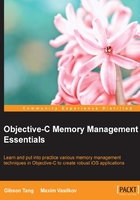
Summary
In this chapter, you learned what memory management in Objective-C is and how it works. You also learned the best practices while working with Manual Retain Release, and got an introduction to Automatic Reference Counting, Objective-C Objects, and root classes. ARC basically can be considered as a compile time guard against memory leaks as the compiler will automatically write the release statements for you at compile time. So, there is no need to write verbose release statements in your code to keep it clean and terse.
One tip to note for coding with memory management is that whenever you do alloc and init, then write your release code after that and put it in its appropriate place in your class, you can forget to call the release method after writing some or fixing some bugs. So writing your object release statements after you do alloc and init will help you to keep memory leaks to a minimum so that you won't have a situation where you get a memory leak as you have forgotten to write your object release statement.
In the next chapter, you will learn more about ARC, how it works, its advantages, how to set up your projects to use ARC and memory models in Objective-C and UI Kit with ARC.